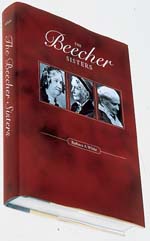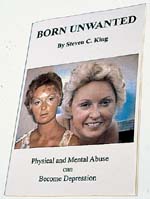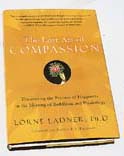 |
 |
| current issue |  |
past issues |  |
send a letter/news |  |
address update |  |
advertise |  |
about us |  |
alumni home |
Cover to Cover
Books by UNH faculty and alumniby Anne Downey '95G
There is Room For You, by Charlotte Bacon
The Beecher Sisters by Barbara A. White
Also of note:
Steven C. King '47
Donald Silverman '59
Janice Harayda '70
Wendy Murdoch '79
Kevin Tracewski '82
Lorne Ladner '92G
Eric D. Knapp '95
There is Room For You
See at amazon.com

Charlotte Bacon, associate professor of English, likes to remind us that we are all travelers forced to read strange maps and decipher unfamiliar codes in a constant quest to be at home in the world. In There Is Room For You, Bacon's second stunning novel, 35-year-old Anna Singer, a grant writer from New York City, takes a trip to India, thinking it will help her cope with her overwhelming sadness; within the past year, she has endured an inexplicable and painful divorce and lost her father in a car accident. She chooses India because it once was the homeland of her mother, Rose. Her mother is a British citizen who was born in Calcutta and lived there until she was 17; beyond these facts, Rose has told her children, Anna and James, very little about her youth. "'So dull, Anna,' she'd say, closing the spigot with a tight turn. An entire childhood cordoned off like a diseased town."
Although Anna doesn't think of her mother as a cruel person, she remembers the "single bed" coldness of her family's emotional life, which was colored by her mother's distant sadness. Now, though, Anna desperately needs a safe harbor, and is wounded enough to understand that she needs to sail through uncharted territory to find it. Rose, it turns out, is willing to share Anna's journey, albeit on her terms: She mails Anna a journal that she has been keeping for the past 30 years that details her life in India. Thus, the novel is composed of a double narrative: Anna's discovery of India in the mid-'90s and Rose's journal of India in the '30s and '40s, a narrative that serves as a map for Anna as she also discovers the devastating secrets that are the key to Rose's character.
This lyrical, immensely moving novel is about citizenship and shared blood, the boundaries we erect in even our most intimate relationships and the journeys that must be taken to cross them. As Anna learns more about Rose, she realizes "there are still acres and acres to cover, regions we will never get to. It's a wonder how vast a country a single parent can turn out to be."
The Beecher Sisters
See at amazon.com
Historians of 19th-century America have likened the Beecher family to the Kennedys of the 20th century, a comparison that only goes so far if you consider that for the Beecher children, there was no family fortune from which to draw. Patriarch Lyman Beecher, a Calvinist minister, was constantly moving his growing family to churches that promised more fiscal stability, and of his 11 children, only Henry Ward Beecher ever attained real financial success. Like the Kennedys, however, the Beechers had a unique family culture that included utter devotion to a charismatic father, unrelenting competitiveness, a zest for religious and intellectual activity and an uncommon moral obligation to serve the public. Indeed, the story goes that the Beechers singularity prompted the Rev. Dr. Leonard Bacon of Yale to say in 1863 that the nation was inhabited by three types of people: saints, sinners and Beechers.

But as Barbara White, professor emerita of women's studies, shows in her biography of the Beecher sisters, it was one thing to be a Beecher male and quite another to be a Beecher female. Lyman Beecher thought any male who had brains should enter the ministry, and all seven of his sons obliged. The four sisters—Catharine, Mary, Harriet and Isabella—did not receive the same encouragement. Catharine and her father were close, and Catharine remembered, "My father never in life praised me, although he used to say that I was the best boy he had."
Although Catharine might have had the temperament most suited to the ministry, it was not an occupation open to women in the mid-1800s. Instead, Catharine devoted her astounding energy to improving educational opportunities for women and to establishing teaching as a female profession. She was single-minded in her pursuits—White calls her "her century's combination of Martha Stewart and Dr. Spock"—and worked until the day she died at age 78.
Harriet earned her father's approval by writing stories. She ran with it, pioneering the genre of local-color realism and attaining the title of Most Famous Beecher when she published Uncle Tom's Cabin in 1852. But it is White's insightful analysis of Isabella Beecher Hooker's life and career that makes this book a significant contribution to 19th century scholarship, as it is the first to uncover the breadth of Isabella's work in the women's suffrage movement. In many ways, Isabella is the most interesting sister of all because she transformed her life in her late 40s; she went from being a wife and mother, and someone seemingly well suited to domesticity, to a national figure in the movement, an adept organizer and an extremely effective public speaker. While we might be used to such transformations in the 21st century, it was unheard of in the 19th. But as White so thoroughly shows, she was a Beecher, and Beechers didn't do anything halfway.
| Also of Note... | |
|
Born Unwanted: Physical and Mental Abuse Can Become Depression,
by Steven C. King '47, The author, a retired scientist, tells the story of his friend "Irene," who suffered debilitating bouts of depression. He traces his friend's problems to childhood trauma and convincingly shows how mental and physical abuse can bequeath a lifelong struggle with depression.
|
 |
|
The Enemy Is Me,
by Donald Silverman '59, Peter Abrams, the protagonist of Silverman's second novel, resents his father's business-comes-first credo, and vows to organize his life differently. However, he discovers a deep-seated desire to surpass his father's middle-class success. This novel unflinchingly shows the costs of valuing material wealth and power above family and relationships. |
 |
|
Manhattan, On the Rocks,
by Janice Harayda '70, This lively novel is a comedy of manners that follows the adventures of 25-year-old Laura Smart, a Midwesterner who leaves a deadbeat boyfriend and an equally unsatisfying job for a more fashionable Manhattan life as an editor at a beauty magazine.
|
 |
|
Simplify Your Riding: Step-by-Step Techniques to Improve Your Riding Skills,
by Wendy Murdoch '79, Written by an acclaimed clinician, this friendly and helpful manual combines theory, instinct and a whole lot of experience with horses to address issues of alignment, position, timing and lengthening.
|
 |
|
A Fisherman's Guide to Maine,
by Kevin Tracewski '82, Tracewski is a biologist and entomologist who is also an avid fisherman. This comprehensive guide, illustrated with beautiful color plates, includes maps, histories, profiles of fisher-folk, and lots of information about where, when and how to catch game fish. |
 |
|
The Lost Art of Compassion,
by Lorne Ladner '92G, Because it can't be easily measured, the author argues, we have discounted compassion, or "an open-hearted empathy for the suffering of others," and have thus become "poor of heart." Written by a clinical psychologist who is also a Buddhist practitioner, this extraordinary book seeks to attain a deep level of dialogue between Buddhism and psychotherapy. |
 |
|
Out of Place Out of Time: the Testimony of Dr. Trenton Stowel,
by Eric D. Knapp '95, A pioneer in the field of quantum theory and time travel has supposedly died in the 1980s. Now he's turned up, with some really bizarre stories involving aliens, and Dr. Katherine Maya, an agent of the Temporal Exploration and Advancement Project must make sense of them. This curiously compelling novel is as much a psychological study as it is a work of science fiction. |
|

